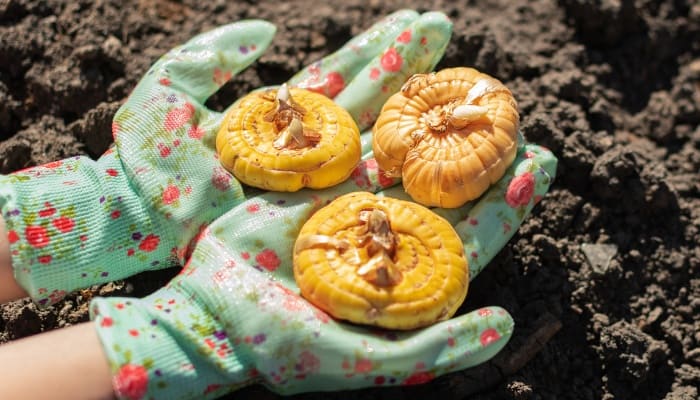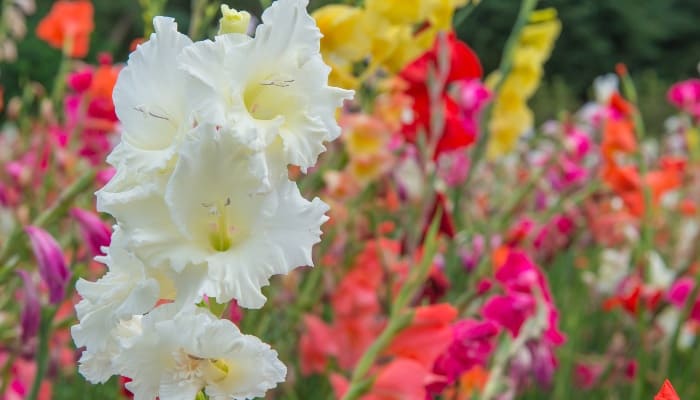During summer to early autumn, it is common to witness the blossoming of gladiolus flowers in soft, warm hues. However, it can be quite disheartening when these plants do not produce any blooms.
Why are my gladiolus not blooming? The most common reasons for gladiolus not blooming include:
- Not enough or incorrect nutrients
- Plants that are too crowded
- Not enough water
- Too little direct sunlight
- Unhealthy or small bulbs
- Incorrect planting depth
- Disease
- Pest-affected plants
- Damage from frost or freezing
As you can see, there are many reasons why your plant is not producing flowers, and it can be difficult to read the signs. Fortunately, we have compiled a detailed list of possible causes and solutions.
Below is our in-depth guide to successfully growing lots of gladiolus flowers.
Gladiolus Not Blooming – 12 Common Causes (& Solutions)
First things first: do not be alarmed if your gladiolus is not flowering. This happens to both novices and garden gurus alike — after all, we are dealing with a living plant, and there are always variables.
1. Not Enough Sunlight
Plants that do not receive enough sunlight (a MINIMUM of 6 hours a day) may appear small, scraggly, and sometimes yellowish. They will also struggle to produce flowers.
Solution
You can easily track sunlight in your yard by observation. Ask yourself questions like:
- Where does the sun travel throughout the day?
- Does this change much during seasons?
- Are there trees or buildings blocking sun?
Often, it is quite easy to transplant gladiolus plants with little shock. To avoid injury, heavy pots should be lifted by capable persons, moved on trolleys, or emptied and then filled again in the right location.
2. Lack of Nutrients
While a lack of nutrients may be obvious with wilting, yellowing, or browning leaves, there may also be no symptoms at all — apart from a missing flowers of course.
Solution
Gladiolus plants prefer a neutral p.H. of around 6.5. To achieve this, try making compost tea or worm casting tea and feeding plants regularly.
You can also use organic fertilizers with a balanced nutrient ratio to ensure plants have the food they need to grow. This mix is excellent for encouraging blooms.
3. Too Much Fertilizer
Of course, too much of a good thing definitely exists, especially in the case of fertilizers. It pays to take note of manufacturer instructions and follow them exactly.
Too much fertilizer can burn roots and leave your plant struggling instead of thriving.
Solution
Flushing excess fertilizer from soil with water can be a productive way to release built-up nutrients. Oftentimes, simply stopping any fertilizer application is the only and best option.
4. Bulb Damage or Rot
Just as a potato or garlic bulb will go bad, so too can tubers and corms, like those from which gladiolus plants grow.
It is important to check the health of your bulbs before planting. Smelly, soft, irregularly shaped, or discolored bulbs should be discarded.
Solution
Bulbs that are damaged or rotten will usually decay in the ground without sprouting. If this is a recurring problem, switch your bulb supplier and try again.
5. Frost or Freeze Damage
Coming from warm to temperate regions across the world, the foliage of most gladiolus varieties does not tolerate frost and may be killed or damaged by even a light frost.
Bulbs that are left in the ground during the freezing temperatures of winter likely will not survive.
Solution
You can really only hope to see whether bulbs will grow at the beginning of a season. End-of-year bulbs that have been exposed to frost or freezing should be discarded as there is no guarantee that they will survive or grow the following year.
6. Insect Damage
Gladioli are susceptible to a few pests, including certain types of wasps, moths, and thrips. These insects can show themselves through many different signs, and it can be difficult to detect exactly what pest is present.
Usually, you can identify a pest through specific damage to plants such as small discolored circles on leaves, drooping or limp plants, or foliage that appears to have been eaten.
Solution
Oftentimes, removing the affected bulb and plant is your best option, making sure to discard and not compost these plants. If symptoms are mild, try applying a natural insecticide.
7. Disease
Disease is rare in gladiolus plants, but it can and does happen to even experienced gardeners. This is because diseases or viruses can enter your garden from anywhere.
Solution
Be sure to inspect and discard corms with visible signs of disease such as a soft consistency, holes, or when they are off-colored.
8. Removing Foliage Too Soon Year the Previous Year
Leaves are how photosynthesis takes place. If the foliage is removed right after the plant flowers, the plant will have no way to produce and store energy in the bulb for the next growing season.
Also, the bulb of the gladiolus is essential for drawing up water and nutrients to the plant; therefore, if the foliage is cut down too soon, then the bulbs will be too active and high in moisture to keep in storage.
Solution
Wait to cut plants until the last flowers have finished and the foliage begins to whither and brown slightly.
9. Small Bulbs
Finding small bulbs of gladiolus is often a sign that plants have been crowded and have not had the room to expand to their full size.
Small bulbs can also mean new, immature plants. These gladioli simply need more time to develop before they are ready to flower.
Solution
While small bulbs can still be stored and planted again, they may take another full year or season to reach a size where they can send up foliage and flowers.
Be sure to give plants sufficient space by planting bulbs around 2-7 inches apart depending on size.

10. Bulbs Planted Too Deeply
Bulbs that are planted too deeply may not have the energy to reach the surface of the soil. This will cause plants to mature later, grow poorly, or not grow at all.
Solution
Planting bulbs about 4 to 6 inches in the ground is a good practice to ensure sufficient root development and close proximity to the surface for sprouting.
11. Bulbs Planted Too Late
It will take around 10 to 12 weeks for your gladioli to reach a stage where it can begin to flower. Taking this into consideration, if bulbs are planted a month before the frost, they will certainly not flower.
Solution
Be sure to keep a close eye on estimated first frost dates, and plant at least three months before this to ensure your plant flowers.
12. Bulbs Planted Too Close Together
Bulbs planted too close together may compete for nutrients and water and become stunted.
Solution
Always give your bulbs enough space to grow. This means around 2 inches apart for very small bulbs and around 7 inches of space for the largest bulbs.
If you notice a patch of highly condensed plants, you can always dig them up and move them if they have not yet matured.
Gladiolus Growth Stages
Gladiolus plants will begin their growth cycle as bulbs. The next stage sees above-ground plant growth for around 10 weeks.
After this period, buds should begin to show on long, sword-like stems, which then bloom for up to two weeks.
Tips for Beautiful Gladiolus Blooms
The best advice for beautiful gladioli blooms is to maintain healthy soil by adding organic compost and mulching plants after sprouting takes place.
Selecting strong bulbs from trusted sellers and feeding with organic fertilizer will also increase your chances of gladiolus blooms.
Conclusion
These warm-weather plants can thrive with only minimal maintenance and reward growers with colorful, eye-catching flowers.
As with most things, it is important to start off on the right foot. By taking the time to be selective of bulbs and planting with care, you too can enjoy these highly popular ornamentals.

